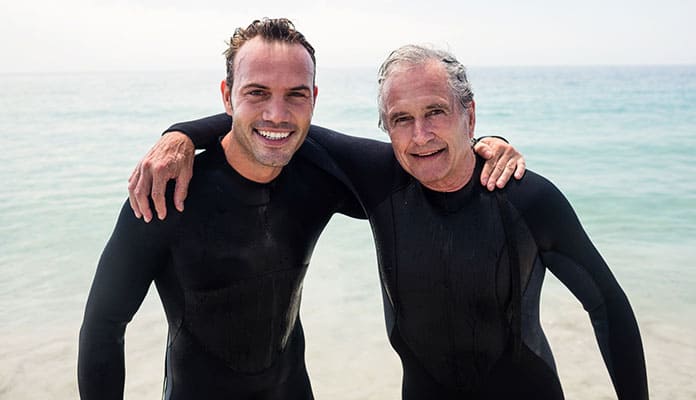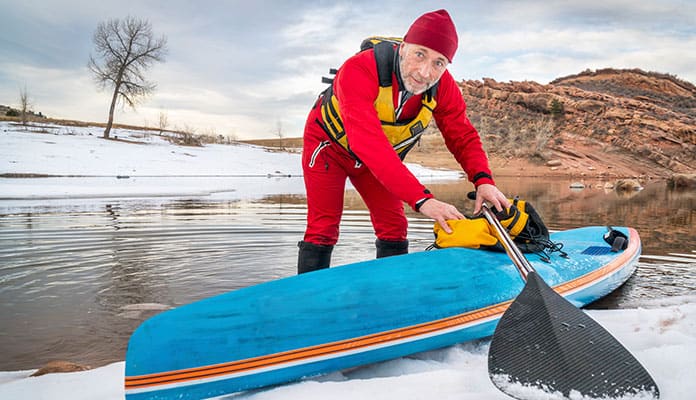
Wetsuits and drysuits are two different types of aquatic clothing, though they both have the same purpose which is to provide users with thermal protection and keep them warm. Most water sports athletes will have one or the other, depending on what aquatic sport they indulge in. But what exactly are the differences between wetsuits and drysuits, and which one should you be wearing? To bring some clarity to the wetsuit vs. drysuit issue, and at the same time help you better decide where to invest your money, here is an overview of wetsuits and drysuits, their different types, and some advice and tips when fitting and purchasing either of the two.
What’s a Wetsuit?
Wetsuits allow a certain amount of water to enter the suit and traps it there, right in the space between the suit’s inner layer and your skin. The heat emanating from your body will warm up the trapped water, and this heated water (together with the insulating properties of the wetsuit) will keep you warm while you enjoy your water activity. In short, you will get wet in a wetsuit (hence the name), but you will stay warm at the same time.
What Types of Wetsuits Are Available?
There are different types of wetsuits available in the market nowadays, and each of these types varies not only in design but also in purpose.
- Full Wetsuits. A full wetsuit covers the whole body of the wearer from the neck to the wrists and all the way down to the ankles.
- Hooded Full Wetsuits. This type of wetsuit is similar to the full wetsuit since it covers the entire body (torso, arms, and legs) of the wearer. However, unlike the full wetsuit, a hooded full wetsuit has a hood attached to it. Accordingly, about 40% of our body heat escapes through our heads. Wearing a hood prevents heat loss and consequently helps the wearer stay warm.
- Long John Wetsuits. Long john wetsuits cover the wearer’s torso and legs all the way down to the ankles. However, these wetsuits lack sleeves, meaning the wearer’s arms are left exposed.
- Short John Wetsuits. Short john wetsuits are similar to long john wetsuits since they both lack arm sleeves. However, short john wetsuits only go as far down as the wearer’s thighs, thus leaving the rest of their legs uncovered.
- Spring Wetsuits. Spring wetsuits look like a short john wetsuit, providing cover for the wearer’s torso and thighs. The difference is that spring wetsuits have complete arm coverage (all the way to the wrists).
- Short Arm Steamers. These wetsuits are similar to long john wetsuits since they offer complete coverage from the neck all the way down to the ankles. However, unlike long john wetsuits that offer complete arm coverage, short arm steamers have sleeves that only run-up to the wearer’s upper arms and leaves the forearms bare.
- Wetsuit Jackets. Wetsuit jackets look pretty much the same as ordinary jackets. These wetsuits cover only the arms and the torso, so the wearer can wear pretty much anything they want for their lower bodies.
- Wetsuit Vest. These wetsuit tops cover only the torso and leave the wearer’s arms bare.
How Should a Wetsuit Fit?
Wetsuits are designed to fit close to the skin. When you wear a wetsuit for the first time, it may feel tight and weird, but that’s how they’re supposed to fit. Think of wearing compression clothing – they’re snug with some pressure on but not to the point that they constrict movement.
When buying your first wetsuit, it is recommended that you choose a snugger fit. This may feel awkward at first, but you have to remember that neoprene wetsuits tend to stretch when they get wet and the more you use them. Just make sure that the tight fit doesn’t restrict your range of motion.
Avoid buying wetsuits that are too large for your body type. A loose wetsuit will let water flow freely in and out of the suit, which means that your body will need to heat the newly-entered water every time. Besides, a loose wetsuit will form awkward folds and air pockets while you’re in the water.
When Should I Wear a Wetsuit?
 When to wear a wetsuit will depend largely on two factors: what you’ll be doing in the water and how the weather is like.
When to wear a wetsuit will depend largely on two factors: what you’ll be doing in the water and how the weather is like.
For instance, you should consider wearing a long john wetsuit or a short john wetsuit if you’re going kayaking or stand-up paddleboarding on days when the air is warm but the water is a bit cold. These types of wetsuits will keep your core and legs warm. Don’t worry about your arms – they will stay warm because of the paddling. Also, the sleeveless design of these wetsuits will allow you to paddle with ease since there are no sleeves that restrict your range of motion.
On the other hand, if you’re going scuba diving on cold days, then you should certainly consider wearing a full wetsuit or even a hooded wetsuit. These wetsuits will allow you to stay under the water for longer so you can enjoy exploring the sea floors and its inhabitants.
Are you planning on paddleboarding or surfing in the ocean? If you’re doing so on a summer’s day, then a wetsuit jacket or a vest should be enough to keep you comfortable without making you feel too hot when under the sun. If you’re a cold water surfer though, a full wetsuit would be a better choice.
What’s a Drysuit?
Unlike wetsuits that let water into the suit, drysuits are designed to keep water out of it. Aside from water-proof fabrics, drysuits have seals and gaskets that fit snugly around the wearer’s neck, wrists, and ankles to further prevent water from getting in. In short, a drysuit keeps you warm and dry.
What Types of Drysuits Are Available?
 Drysuits are usually categorized into two main styles: paddling drysuits and diving drysuits.
Drysuits are usually categorized into two main styles: paddling drysuits and diving drysuits.
- Paddling Drysuit. These types of drysuits are worn by kayakers, canoers in the lake, and stand-up paddleboarders. Although they have seals or gaskets around the neck, wrists, and ankles, paddling drysuits won’t be able to keep you completely dry if you fall out of your vessel.
- Diving Drysuits. These types of drysuits are what you see scuba divers wear. Compared to the paddling drysuit, a diving drysuit is heavier and is made from more robust materials. They also have various technical features like an inflator valve (used to add air into the drysuit) and an exhaust valve (used to release air from the drysuit).
Drysuits can also be categorized depending on the materials they’re made from.
- Neoprene Drysuits. These drysuits are made from neoprene, flexible synthetic rubber with minute nitrogen bubbles inside.
- Membrane/Trilaminate Drysuits. These drysuits are manufactured using various materials, but they all feature a sandwiched layer of thin, waterproof neoprene rubber or butyl between the inner and outer layers.
How Should a Drysuit Fit?
In general, a drysuit is loose-fitting compared to a wetsuit. One reason for this is because, in most instances, you’ll want to wear thermal or normal clothes (like long-sleeved shirts or thin, wool socks) underneath the drysuit for added warmth. This is why you should be wearing some type of under-clothing when you’re trying on a drysuit.
There are exercises you can do to determine if the drysuit you intend to purchase fits you well. You’ll need to do these exercises with the dry suit and under-clothing on.
- Raise one hand and reach for your back, as though you’re attempting to reach a scuba tank slung behind you. Do the same with the other hand. If you’re having trouble doing this exercise, then the drysuit is probably too small for you.
- With your feet shoulder-width apart, lower yourself into a squatting position. The movement should be easy and not restricted, and if it is then the suit may be too small.
- Put one foot in front of you and kneel. Do the same with the other foot. Again, there should be no feeling of restriction or tightness.
- While standing up, spread your legs apart as if you’re doing a split (don’t go into a full split though). If the drysuit is too small, the crotch will be too low prevent you from successfully performing this exercise.
Aside from the drysuit itself, you need to make sure that the seals or gaskets fit nice and tight. If the seals and gaskets are loose, water will trickle down the openings and enter the suit. If the water enters through the neck seal, it will trickle down your back, and this can lead to a cold and uncomfortable diving experience.
When Should I Wear a Drysuit?
As it is with wetsuits, the choice between wearing and not wearing a drysuit will be influenced by what activity you’re doing and the weather.
In general, though, you’ll want to wear drysuits when the weather and the water are extremely cold. And although your drysuit and under-clothing should be enough to keep you warm, you may want to consider wearing additional layers of clothing to completely protect yourself from hypothermia when doing out of the water activities like kayaking or canoeing.
If you’re taking a paddling trip on a very cold day and very cold waters, then you should certainly wear a paddling drysuit. And if you’re going for a dive on a similar day, then a diving drysuit is certainly necessary.
Globo Surf Overview
So the next time you get into a wetsuit vs. drysuit debate, just keep the following in mind: in a wetsuit, you’ll be wet but warm, whereas in a drysuit you will stay dry and warm. When buying a wetsuit or a drysuit, you need to make sure that they are the right fit; otherwise, you could end up with a very uncomfortable feeling and may want to prematurely end your water sports adventure. But aside from the fit, you should also make sure that you are buying wetsuits or drysuits made from high-quality materials. In doing so you are assured that you are getting a suit that is built to last and that you can enjoy using for a very long time.
More Kayak Reviews:
- Recreational Kayak
- Fishing Canoe
- Kayak Cooler
- Kayak Accessories
- Kayak Anchor
- Bow Rudder
- How To Get In A Kayak
- Snow Kayaking
- Wetsuit Vs Drysuit Kayaking
- Kayak Paddle Drip Rings
Source
-
- Hypothermia, medicalnewstoday.com

